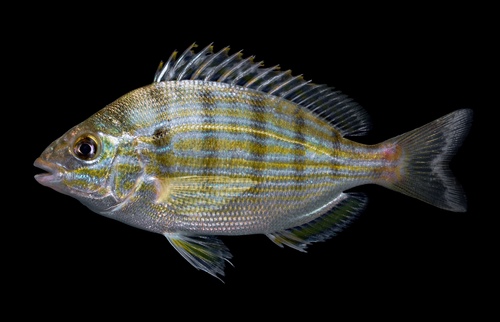
Pinfish
The Atlantic bluefin tuna (Thunnus thynnus) is a majestic and powerful fish renowned for its size, speed, and migratory prowess. This apex predator plays a vital role in the marine ecosystem and holds significant commercial value.
3 7 years
Lifespan
40 cm
Length
Least Concern
Conservation Status
Omnivorous
Diet
Local Migration
Migration
Appearance Overview
The Atlantic bluefin tuna is a large, torpedo-shaped fish with a metallic blue-black back and a silvery-white belly.
Coloration
Dark metallic blue on top, silvery-white underside
Body Shape
Torpedo-shaped, streamlined
Fins
Two dorsal fins, the first depressible; small finlets behind second dorsal and anal fins
Keel
Strong keel on each side of the tail base
Length
Up to 13 feet (4 meters), commonly 6.5 feet (2 meters)
Weight
Up to 2,000 lbs (907 kg), commonly around 550 lbs (250 kg)
Diet
Carnivorous, feeding on a variety of fish (such as mackerel, herring, and bluefish), squid, and crustaceans.
Feeding Behavior
Opportunistic and highly active predators, they use their speed and agility to hunt. They often hunt cooperatively, herding and trapping prey.
Social Behavior
Highly migratory, forming large schools, especially during spawning. Schools may be segregated by size.
Commercial Relevance
Extremely high value, especially in sushi and sashimi markets, where a single fish can fetch hundreds of thousands of dollars.
Conservation measures
Managed under international agreements and national regulations, including fishing quotas, size limits, and gear restrictions. Organizations like ICCAT play a key role.
Status
Endangered (IUCN)
Threats
Overfishing (historically and ongoing in some areas), bycatch in fishing gear, habitat degradation, and climate change affecting prey distribution.
Habitat Distribution
Depth Range
0-1,000 meters (0-3,280 feet), most commonly found in the upper 200 meters (656 feet)
Geographic Range
Western and Eastern Atlantic Ocean, Mediterranean Sea, and formerly the Black Sea.
Preferred Environment
Temperate and subtropical waters; pelagic, open ocean environments; also found in coastal areas.
Reproduction and Life Cycle
Breeding Habits
Spawns in warm waters, primarily in the Mediterranean Sea and the Gulf of Mexico. Spawning occurs in large aggregations.
Development Stages
Eggs hatch into larvae, which develop rapidly. Juveniles grow quickly, reaching significant size within their first year.
Fecundity
Highly fecund; a single female can produce up to 30 million eggs per spawning season.
Maturity Age
Reaches sexual maturity at around 4-8 years in the Mediterranean and 8-12 years in the Western Atlantic.
Faqs about Pinfish
How fast can Atlantic bluefin tuna swim?
Atlantic bluefin tuna are among the fastest fish in the ocean, capable of reaching speeds up to 43 mph (70 km/h) in short bursts.
How long do Atlantic bluefin tuna live?
They can live up to 40 years, although most live to around 15-25 years due to fishing pressure.
Are Atlantic bluefin tuna warm-blooded?
Atlantic bluefin tuna have a unique ability to maintain a body temperature higher than the surrounding water, allowing them to thrive in a wide range of temperatures.
How far do Atlantic bluefin tuna migrate?
They undertake long migrations across the Atlantic Ocean, often traveling thousands of miles between feeding and spawning grounds.
Can you eat Atlantic Bluefin Tuna?
Yes, but it is highly regulated due to their conservation status. Consumers should look for sustainably sourced options and check local regulations.
Besides sushi, how else can bluefin tuna be cooked?
While often associated with sushi, Atlantic bluefin tuna can also be grilled, seared, or baked. Overcooking should be avoided.
Why is bluefin tuna so expensive?
The high price is driven by demand (particularly in Japan), the cost of fishing, and the relatively limited supply due to fishing quotas.
What is the role of bluefin tuna in the ecosystem?
They are apex predators, playing a crucial role in maintaining the balance of marine ecosystems by controlling populations of their prey species.
Copyright @ Nature Style Limited. All Rights Reserved.
 English
English